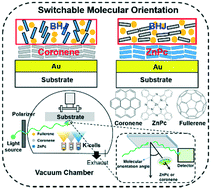当前位置:
X-MOL 学术
›
Mol. Syst. Des. Eng.
›
论文详情
Our official English website, www.x-mol.net, welcomes your
feedback! (Note: you will need to create a separate account there.)
Substrate-driven switchable molecular orientation in bulk heterojunction films identified using infrared reflection absorption spectroscopy
Molecular Systems Design & Engineering ( IF 3.2 ) Pub Date : 2019/12/17 , DOI: 10.1039/c9me00165d Md. Shahiduzzaman 1, 2, 3, 4 , Tomoki Hirayama 2, 3, 4, 5 , Tatsuki Chikamatsu 2, 3, 4, 6 , Tomoyuki Koganezawa 4, 7, 8 , Masahiro Nakano 2, 3, 4, 6 , Tetsuhiko Miyadera 4, 9, 10, 11 , Makoto Karakawa 1, 2, 3, 4, 5 , Kohshin Takahashi 2, 3, 4, 6 , Tetsuya Taima 1, 2, 3, 4, 5
Molecular Systems Design & Engineering ( IF 3.2 ) Pub Date : 2019/12/17 , DOI: 10.1039/c9me00165d Md. Shahiduzzaman 1, 2, 3, 4 , Tomoki Hirayama 2, 3, 4, 5 , Tatsuki Chikamatsu 2, 3, 4, 6 , Tomoyuki Koganezawa 4, 7, 8 , Masahiro Nakano 2, 3, 4, 6 , Tetsuhiko Miyadera 4, 9, 10, 11 , Makoto Karakawa 1, 2, 3, 4, 5 , Kohshin Takahashi 2, 3, 4, 6 , Tetsuya Taima 1, 2, 3, 4, 5
Affiliation

|
This research evaluated the substrate effects of two organic molecules, zinc phthalocyanine (ZnPc) and coronene on a glass/Au/coronene substrate (coro sub) and coronene:C60 BHJ film on a glass/Au/ZnPc substrate (ZnPc sub). The interaction strength of the co-evaporated ZnPc:C60 bulk heterojunction (BHJ) films was measured. The molecular orientation angles of each molecule in the BHJ films were detected by in situ infrared reflection absorption spectroscopy. Coronene molecules in the coronene:C60 film on the ZnPc sub could be precisely controlled to attain a lying-down orientation owing to the strong π–π interaction between the coronene–ZnPc molecules. In contrast, the ZnPc molecules in ZnPc:C60 adopted a standing-up orientation on the coro sub owing to the weak π–π interaction between the ZnPc sub and ZnPc molecules. The present work presents an important finding which indicates that substrate-dependent molecular orientation switches may be possible for both transistor and solar cell applications.
中文翻译:

使用红外反射吸收光谱法确定本体异质结薄膜中的基质驱动的可转换分子取向
这项研究评估了两种有机分子对玻璃/ Au /二甲苯基体(coro sub)和在玻璃/ Au / ZnPc基体上的coronene:C60 BHJ膜(ZnPc sub)上的酞菁锌(ZnPc)和并苯的有机底物的影响。测量了共蒸发的ZnPc:C60本体异质结(BHJ)薄膜的相互作用强度。通过原位检测BHJ膜中每个分子的分子取向角红外反射吸收光谱法。ZnPc子上的coronene:C60膜中的coronene分子由于coronene-ZnPc分子之间存在很强的π-π相互作用,因此可以精确控制其躺卧方向。相比之下,由于ZnPc子与ZnPc分子之间的π-π相互作用较弱,ZnPc:C60中的ZnPc分子在coro子表面上具有直立取向。本工作提出了一个重要发现,表明对于晶体管和太阳能电池应用,依赖于衬底的分子取向开关都是可能的。
更新日期:2020-02-24
中文翻译:

使用红外反射吸收光谱法确定本体异质结薄膜中的基质驱动的可转换分子取向
这项研究评估了两种有机分子对玻璃/ Au /二甲苯基体(coro sub)和在玻璃/ Au / ZnPc基体上的coronene:C60 BHJ膜(ZnPc sub)上的酞菁锌(ZnPc)和并苯的有机底物的影响。测量了共蒸发的ZnPc:C60本体异质结(BHJ)薄膜的相互作用强度。通过原位检测BHJ膜中每个分子的分子取向角红外反射吸收光谱法。ZnPc子上的coronene:C60膜中的coronene分子由于coronene-ZnPc分子之间存在很强的π-π相互作用,因此可以精确控制其躺卧方向。相比之下,由于ZnPc子与ZnPc分子之间的π-π相互作用较弱,ZnPc:C60中的ZnPc分子在coro子表面上具有直立取向。本工作提出了一个重要发现,表明对于晶体管和太阳能电池应用,依赖于衬底的分子取向开关都是可能的。







































 京公网安备 11010802027423号
京公网安备 11010802027423号